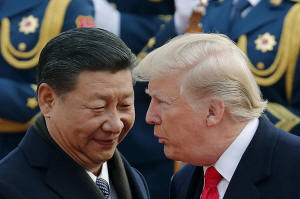A timeline of US-China tit-for-tat tariffs since Trump's first term
 Send a link to a friend
Send a link to a friend
 [February 10, 2025] By
SIMINA MISTREANU [February 10, 2025] By
SIMINA MISTREANU
TAIPEI, Taiwan (AP) — China’s tit-for-tat duties on U.S. imports took
effect Monday, just hours after U.S. President Donald Trump announced
that he wants to slap new duties on all steel and aluminum imports to
the U.S.
The rapid-fire shots of tariffs and import curbs hearken back to Trump’s
first term in office, when the U.S. and China engaged in a trade war
that spanned most of Trump’s first four years in office and was
continued to a certain extent under his successor, Joe Biden.
Less than a month after returning to the White House on Jan. 20, Trump
slapped 10% duties on all Chinese imports, a move that’s expected to
raise prices on goods including laptops, toys and fast fashion.
China responded with 15% duties on coal and liquefied natural gas
products, and a 10% tariff on crude oil, agricultural machinery and
large-engine cars imported from the U.S.
Beijing also launched an anti-monopoly investigation into Google and
added PVH, the owner of U.S. fashion brands Tommy Hilfiger and Calvin
Klein, to its “unreliable entity” list. China also restricted the
exports of five rare metals used as key components in the defense and
clean energy industries among others.
As the new frictions threaten to escalate into a trade war, here are
some key moments in the countries’ yearslong trade spat:

March 2017
Shortly after becoming U.S. president for the first time, Trump,
determined to reduce trade deficits with other countries, signs an
executive order calling for tighter tariff enforcement in anti-dumping
cases.
April 2017
During a visit to Beijing, Trump and Chinese President Xi Jinping agree
to a 100-day plan for trade talks meant to reduce the U.S. trade deficit
with China. The trade talks fail by July.
August 2017
Trump launches an investigation into alleged Chinese theft of U.S.
intellectual property, which the U.S. estimated was costing it up to
$600 billion a year.
January 2018
The U.S. announces 30% tariffs on imported solar panels, which come
mostly from China.
April 2018
Beijing hits back with tariffs on U.S. imports worth about $3 billion,
including 15% duties on products including fruits, nuts, wine and steel
pipes, and a 25% tax on pork, recycled aluminum and six other types of
goods.
A day later, the U.S. ups the ante by slapping a 25% tax on Chinese
goods from the aerospace, machinery and medical industries worth about
$50 billion. China retaliates with 25% duties on aircraft, automobiles,
soybeans and chemicals among other imports, worth about another $50
billion.
[to top of second column] |

U.S. President Donald Trump, right, chats with Chinese President Xi
Jinping during a welcome ceremony at the Great Hall of the People in
Beijing on Nov. 9, 2017. (AP Photo/Andy Wong, File)
 June-August 2018
The two countries impose at least three more rounds of tit-for-tat
tariffs affecting more than $250 billion worth of Chinese goods and
more than $110 billion worth of U.S. imports to China. These include
10% tariffs on $200 billion of Chinese goods that take effect in
September 2018 and are supposed to increase to 25% on Jan. 1, 2019.
December-May 2019
Washington and Beijing fail to iron out a trade deal after agreeing
to halt new tariffs in December 2019. After the talks collapse,
Trump goes ahead and raises tariffs from 10% to 25% on $200 billion
worth of Chinese goods.
May 2019
Washington bans Chinese technology company Huawei from buying parts
and components from U.S. companies.
June 2019
Trump and Xi agree in a phone call to restart trade talks, but these
hit numerous snags in the next five months.
January 2020
The U.S. and China sign a Phase One trade deal through which China
commits to buying an additional $200 billion of U.S. goods and
services over the next two years. However, a research group later
found China had bought essentially none of the goods it had
promised.
October 2022
Biden, who had retained most of the tariffs enacted under Trump,
issues sweeping new restrictions on selling semiconductors and
chipmaking equipment to China. These curbs will be expanded in
October 2023 and December 2024.
February 2024
On his campaign trail, Trump says that he plans to impose tariffs of
at least 60% on all Chinese imports if he wins a second term in
office.
May 2024
Biden raises tariffs on Chinese electric vehicles, solar cells,
steel, aluminum and medical equipment.
Feb. 4, 2025
New 10% tariffs on all Chinese imports to the U.S. come into effect.
China retaliates the same day by announcing a flurry of
countermeasures, including the duties on American coal, liquefied
natural gas and agricultural machinery.
All contents © copyright 2025 Associated Press. All rights reserved
 |